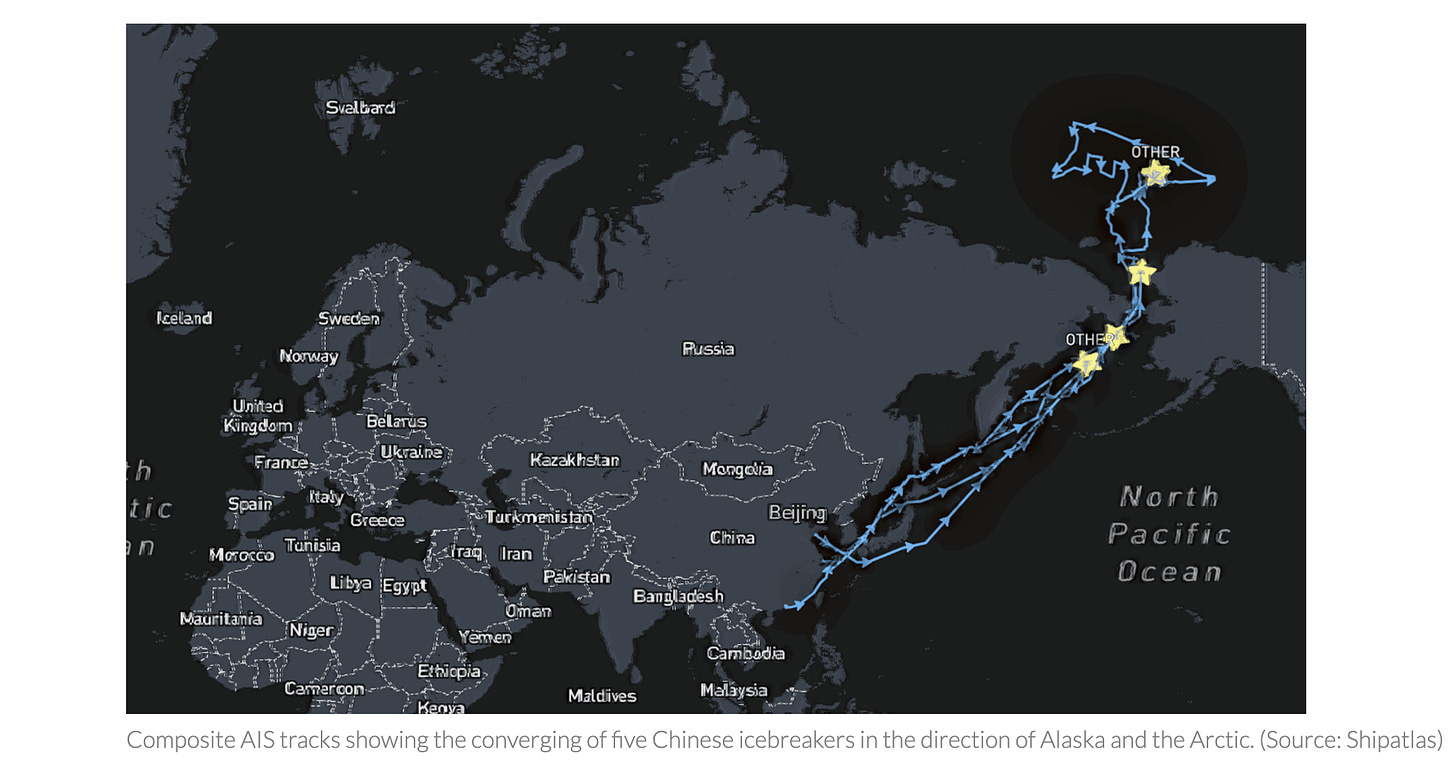-Apologies to the Bard
When you have the world’s largest navy, you soon realize you can be everywhere, all at once, because you want to.
We all had fun at the People’s Republic of China’s (PRC) navy and coast guard’s expense yesterday in Operation Bumper Boats, but now it is time to get back to serious things.
As we discussed six months ago, the PRC is not an Arctic nation. It has, at best, a tertiary concern with the Arctic. Just look at the chart at the top of last week’s post, no PRC coastline to be seen.
That isn’t stopping her.
While we continue to try to figure out a way to catch up in the icebreaker game, the PRC is already there.
They are not doing this for pure research; they are looking at how to leverage every corner of the planet for military and economic gain for themselves.
They have no other reason to be there.
Via Malte Humpert at gCaptain:
In a significant show of Arctic prowess, China has dispatched five icebreaking research vessels to the region. This is the first time the country has operated more than three icebreaking vessels in the Arctic simultaneously.
The flotilla is led by China’s largest domestically-built icebreaker Xue Long 2. The Polar Class 3 vessel departed from Shanghai on July 5. It has since been operating in the Chukchi and Beaufort Seas adjacent to Alaska and Russia. Its ultimate destination is not currently known. Last summer the vessel concluded its Arctic sailing with a port visit to Russia’s largest Arctic city Murmansk. Both the U.S. Coast Guard and Canadian military have shadowed Xue Long 2’s activities in recent weeks.
Xue Long 2 was joined in the Arctic on July 30 by Shen Hai Yi Hao, an ice-class research vessel specialized on ROVs (Remotely Operated Vehicles) and AUVs (Autonomous Underwater Vehicles) owned by China Ocean Mineral Resources R&D Association (COMRA). It carries the submersible Jiao Long designed for dives down to 7,000 meters. Shen Hai Yi Hao departed from Qingdao on July 16 and is currently operating in proximity of Xue Long 2 to the northwest of Alaska at the edge of Chukchi and Beaufort Seas.
....MORE.
Some previous posts regarding China in the Great White North:
- "China’s Emerging Strategies in the Arctic"
- "China’s Polar Strategy: An Emerging Gray Zone?"
- "Pentagon warns of risk of Chinese submarines in the Arctic"
- "Don't Fear China's Arctic Takeover"
- "How To Avoid A Naval Cold War In The High North"
- Natural Gas: "Chinese oilmen make big discovery in Russian Arctic waters"
- "China opens bids for first nuclear-powered icebreaker"
- China seeks a more active role in the Arctic
China defines itself as a near-Arctic state and says it will actively participate with wisdom and strength to future protection and development. Roger that, wisdom and strength, over.Flashback, June 2018:
...On the other hand, if you read Xinhua's translation of January's "Full text: China's Arctic Policy" you'll note they call themselves a ‘Near-Arctic state’.Additionally China is couching their interest in terms of research:
This is to counter people like me using the 'non-polar' or 'non-Arctic' phrasing.
States from outside the Arctic region do not have territorial sovereignty in the Arctic, but they do have rights in respect of scientific research, navigation, overflight, fishing, laying of submarine cables and pipelines in the high seas and other relevant sea areas in the Arctic Ocean, and rights to resource exploration and exploitation in the Area, pursuant to treaties such as UNCLOS and general international law. In addition, Contracting Parties to the Spitsbergen Treaty enjoy the liberty of access and entry to certain areas of the Arctic, the right under conditions of equality and, in accordance with law, to the exercise and practice of scientific research, production and commercial activities such as hunting, fishing, and mining in these areas....
